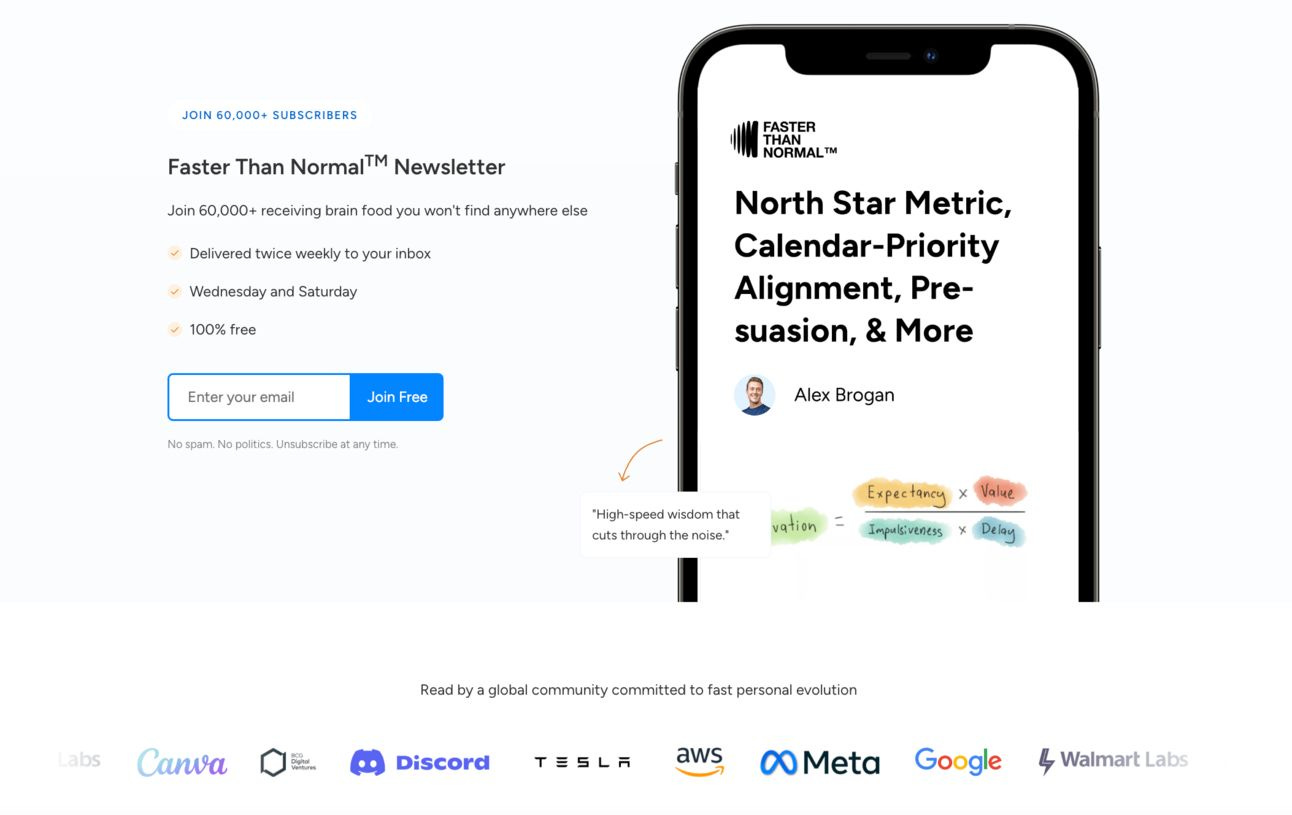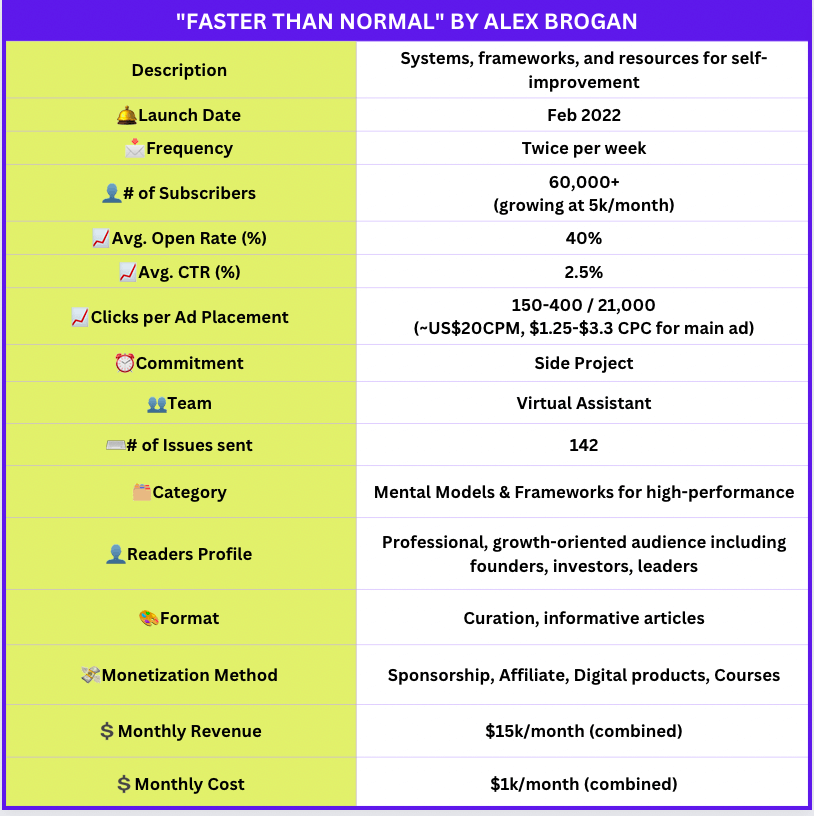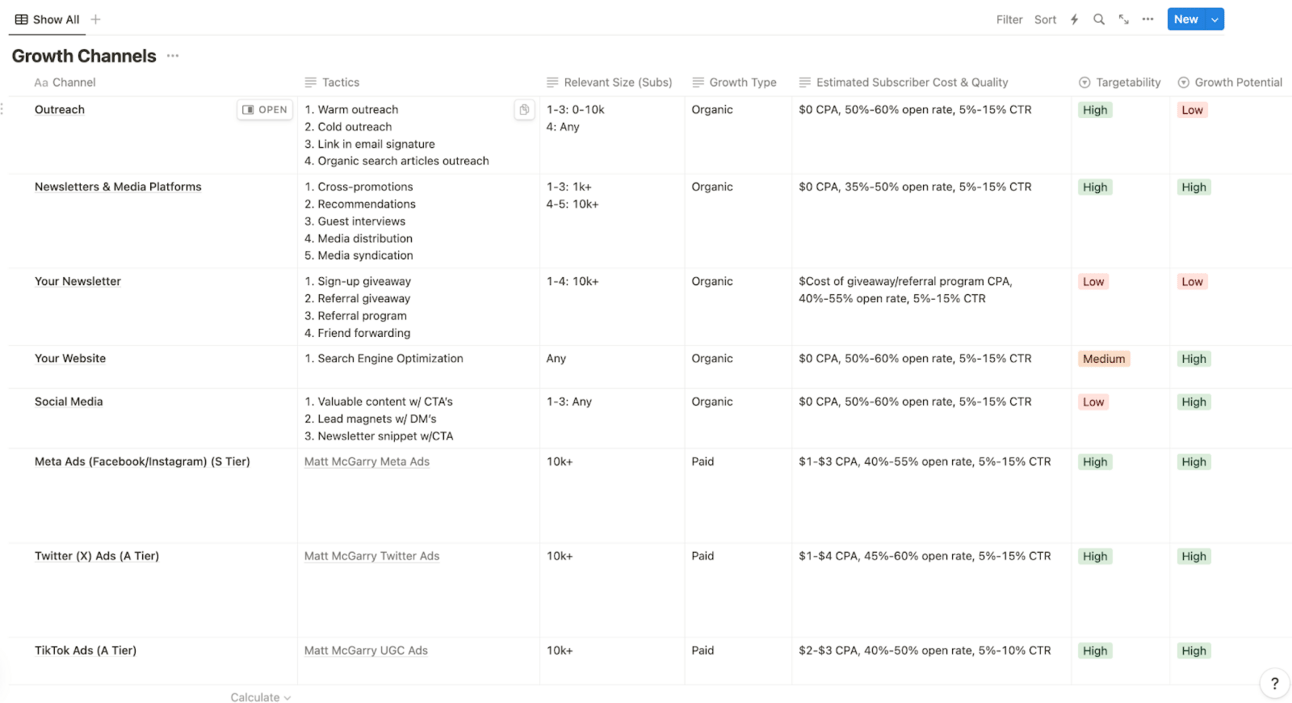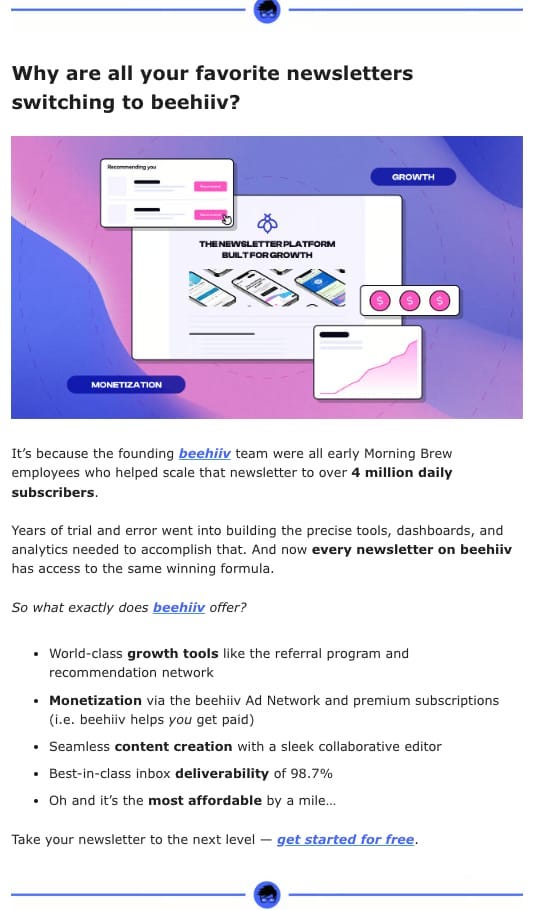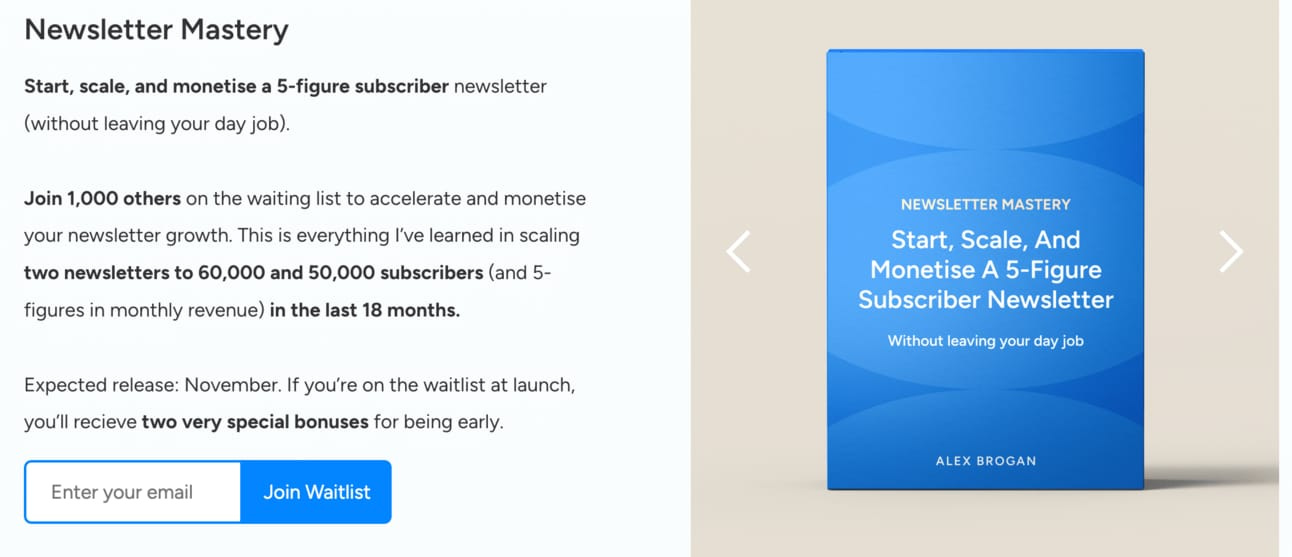Faster Than Normal by Alex Brogan
"The first 1,000 subscribers are the hardest. If you can get there, you can get to 100,000—all it takes is time!"
Newsletter Circle is the newsletter all about newsletters for indie creators.
👉 Every Sunday, you will read the unique journey of a different newsletter creator and learn more about how to start, grow and monetize your own newsletter.
👉 Every Wednesday, you will read articles and the list of curated resources to level up your newsletter business.
🎙CREATOR INTERVIEW
Alex Brogan scaled two newsletters to 50,000 and 60,000 subscribers (and 5-figures in monthly revenue) in the last 18 months.
It is obvious that he cracked the code of building a profitable newsletter business.
Want to know his secret?
Welcome to a two-part interview series where we'll uncover the strategies that led to his success!
But that's not all – Alex is ready to generously share his wealth of experience with creators of all levels with his Newsletter Mastery Course, and you can join the waitlist right now.
In our exclusive interview, we'll delve into:
How Alex kickstarted his newsletter journey
Why having a newsletter is the rock-solid foundation of any online business
The evolution of growth strategies he masterfully employed along the way
The right time to start monetizing your newsletter
Different ad strategies
How to price newsletter ads
The most critical factors to turn a partnership into success
Get ready to level up your newsletter game and let’s dive in!
🏷 NEWSLETTER IDENTITY CARD
🛠 Tool Stack
ESP → Beehiiv
Writing → Notion
Planning & Task Management → Notion
Website → Webflow
Design → Canva
Growth → Lettergrowth, Sparkloop
Lead Magnets → Notion
Website Analytics → Plausible
Payment → Stripe
👋 MEET THE CREATOR
Welcome Alex. Let’s start with getting to know you.
Previously, I worked at Goldman Sachs for two years (2019-2020) in the Investment Banking Division, helping companies grow and raise capital. I also played Water Polo for Australia (2015) and was Valedictorian of my graduating class at the University of Western Australia (2017).
I also spent time at an NFT Art Studio in growth and at a Growth Marketing Agency called Ammo Marketing, focusing on organic and paid social.
Most recently, I was Head of Go To Market at Zipline, a Series A B2B healthcare startup. Zipline aims to solve some of the most pressing challenges in the healthcare industry throughout the United States and Australia.
I’m now splitting my time between two newsletters: Faster Than Normal and The Intelligence Age.
🥁 START
Why and how did you decide to start Faster Than Normal in the first place?
I started Faster Than Normal after beginning to build an audience on Twitter. I principally decided to start it to explore my curiosity around high-performance frameworks, but there were critical business reasons for doing so too:
Email is an owned channel. The list you build is yours to keep—no tech behemoth or rogue CEO can take it from you.
Email is everywhere. Most of the 8 billion people on our planet have an email address. This isn’t the case for social media platforms.
Email is direct. Algorithms don’t decide whether your email reaches your readers—you do.
Email is personal. Email is an opportunity to deepen the relationship with your subscribers, your investors, your customers, your fans—anyone.
Email has the best ROI. Email is known to have the highest ROI out of any marketing channel.
Email is the foundation of modern businesses. I’ve counted over 17 monetisation methods that can be built on a newsletter, including digital products, paid newsletters, memberships, SaaS, Agencies, Investment Funds, and more.
“If you’re serious about starting to succeed with an online business, email is an essential ingredient that you cannot live without.”
Then, at which point did you think adding another newsletter, The Intelligence Age, is a good idea?
My cousin, Casey, and I had been discussing ideas to work on. Casey’s background and deep passion is in Artificial Intelligence. The combination of my newsletter experience and Casey’s interest made it a good idea to pursue!
🚀 GROWTH
You grew 50k+ subscriber newsletters in the last 18 months while working full-time. This is impressive. Let’s focus on one of them, which is Faster Than Normal.
How did you gain your first 1,000 subscribers?
“My Answer?
Doing Things That Don’t Scale.
The first 1,000 subscribers are the hardest. If you can get there, you can get to 100,000—all it takes is time!”
Doing things that don’t scale is a concept popularised by Paul Graham.
The idea is to do things that you wouldn’t do at scale:
Ask your family, friends, coworkers (anyone with a heartbeat that you know)
Share your newsletter in communities (Pro tip: Choose ones where you have an existing affinity; add value before asking)
Add value to social posts with a link to your newsletter
Once you get to 300-500 subscribers, look for Newsletters of a similar size in a related niche and ask to do reciprocal shares. Use Lettergrowth to find cross-promotions.
After reaching 1,000 subscribers, is it time to start “doing things that scale”? Can you tell us how your growth strategy evolved after the first 1,000?
Here is the full summary:
— 0-1000 Subscribers—
Step 1: Do Things That Don’t Scale
— 1000-10,000 Subscribers —
Step 2: Organic Social Media
Building a newsletter without it is a herculean task.
When starting Faster Than Normal, I focused on a single platform—Twitter. Each platform has nuances, and it’s best not to spread yourself too thin.
Over time, I added LinkedIn and Instagram.
Create valuable content and invite people to join your newsletter after posting with a “Call-To-Action” at the end of your post.
“Pro Tip: Start with Twitter or LinkedIn because they’re text-based, meaning that folks on these platforms enjoy written content (like newsletters!).”
— 10,000 - 25,000 Subscribers—
Step 3: Recommendations & Cross Promotions:
Recommendations are when you subscribe to a newsletter and see 2-4 other newsletters that you can sign up to—now extremely common on Beehiiv, Substack, and ConvertKit.
Cross-promotions are when you organize a reciprocal ‘share’ in someone else's newsletter.
We’ve used both of these heavily on the journey to 50k subscribers.
— 25,000 - 50,000 Subscribers—
Step 4: Paid Growth (Refind, Upscribe)
We’ve relied most heavily on Refind and Upscribe by Sparkloop given their simplicity.
“The key to paid growth is only to start investing here when each additional subscriber you pay for adds more value than they cost (LTV > CAC)”
A simpler way to think about it is that you want to make sure you’re profitable before you start spending on ads, and then only spend up to your breakeven point.
This isn’t sweeping advice; only what we choose to do to keep growing.
While these steps are listed sequentially, in reality, once you start a new step, you don't stop the previous one.
— 50,000+ Subscribers—
Step 5: More Paid Growth (Twitter, Facebook, TikTok, Quora)
So, in the end, you’ll be doing Step 1 + Step 2 + Step 3 + Step 4 + Step 5, only in different proportions depending on what’s most effective.
Which growth channels do you mainly use currently?
All of the above, but hardly any things that don’t scale!
Can you elaborate a bit on how you utilized Recommendations, as one of the most effective growth strategies?
Step 1: Find candidates (using Directories, Sparkloop, or Beehiiv) with good audience crossover, a similar list size, and similar flow (the number of subscribers they’re adding per month)
Step 2: Send an email like the following:
Hey ____, I run an AI newsletter called The Intelligence Age, it's a daily, curated AI newsletter focused on the business implications of AI. It’s mostly read by senior leaders and technical folks.
We have 50k subscribers (40% open rate + 3% click through rate) at the moment and a premium community of ~100 folks where we go a bit deeper into business use cases and AI implementation.
Since there's almost certainly a good amount of overlap between the audiences for The Intelligence Age and _____ would you be interested in setting up reciprocal recommendations to help grow both of our audiences?
Let me know if you'd be open to this!
Alex
We dive into over 30 growth strategies in the Newsletter Mastery Course:
💸 MONETIZATION
When is the right time to monetize a newsletter?
"The short answer to “When to monetize?” is as soon as you’d like to or have the opportunity to.”
This can be when:
You need to pay your bills
You find brands that you’d like to become an affiliate for that your readers would love
Your readers are asking for a digital product
Your readers are asking for coaching
Your subscriber base is large enough that you start attracting inbound sponsorship interest
You have the skills or expertise to charge immediately for premium subscriptions
There are no rules or correct answers here, only what’s right for you. In most cases, first-timers (myself included) overthink this question.
In reality, you’ll have hundreds of opportunities to monetize and it’s an ongoing evolution—not one distinct event.
That said, here are two critical pieces of advice to consider:
Begin with the end in mind
This one is simple: Don’t hamstring yourself by committing to a pathway too early that might be sub-optimal in the long term.
Examples of this include:
Becoming an affiliate for someone else’s digital product when you plan to make and sell a similar digital product in the future. This can cause a loss of trust in your audience.
Creating a paid newsletter by putting a paywall around your content. In turn, this limits your total subscribers (and growth) and ability to take advantage of other monetization opportunities (like Sponsorships).
When in doubt, optimize for optionality. If you’re not in a rush, play the long game.
Start when you can demonstrate demand
A more specific answer to the when to monetise question is:
When you can show need for products and services within your newsletter.
The best way of answering this question?
Choose an affiliate product or service that you use, like, and that aligns with your existing subscriber base
Create a test advertisement of the affiliate offer, like this:
Measure the click-through-rate and conversions (how many people buy).
Reach out to sponsors you want to work with and share the click-through rate and conversions on the affiliate offer. Depending on the organization, they’ll either be interested or they won’t.
Most sponsors would be interested in a conversation when you can demonstrate 100 clicks and/or 2-5% conversion on the advertisement. If you’re not at that stage yet, keep focusing on growth before spending time on sponsors!
How should a creator decide on the price of newsletter ads?
The key things to understand about pricing ads are:
It’s half art, half science
There’s no such thing as a standard sponsorship
Pricing is always a negotiation between the newsletter (you) and the sponsor
Understanding the goals of the sponsor is key to the negotiation
A flat fee is the least risky pricing model for newsletters
Cost per acquisition is the most risky pricing model for newsletters
There are four main ways to price ads in your newsletter:
Flat Fee: A flat fee arrangement involves a straightforward agreement where a sponsor pays a predetermined amount for advertising space in your newsletter, irrespective of the number of clicks or conversions generated. For example, if a sponsor agrees to a flat fee of $2,500 for an advertisement spot in your newsletter, you'll receive $2,500 regardless of the engagement metrics.
CPM (Cost Per Mille): CPM denotes the price of 1,000 advertisement impressions on a single page. If your newsletter has a readership of 150,000, and you set a CPM rate of $15, it means you charge $15 for every 1,000 readers reached. To calculate the total cost for a sponsor: 150,000 divided by 1,000 equals 150. Therefore, the total cost would be $15 (CPM) X 150 = $2,250 per sponsorship. In the newsletter world, the CPM is based on your total list size, not total opens.
CPC (Cost Per Click): CPC represents the amount paid by an advertiser every time a reader clicks on their advertisement within your newsletter. For instance, if an advertiser agrees to a CPC of $2 and your newsletter generates 400 clicks on their ad, the total revenue you'd earn is calculated as $2 (CPC) X 400 clicks = $800.
CPA (Cost Per Acquisition): CPA refers to the amount an advertiser is willing to pay for each action or conversion generated through your newsletter, such as app sign-ups or product purchases. Suppose a sponsor agrees to a CPA of $10 for each user you drive to register for their service, and you manage to get 200 sign-ups. In this scenario, you would earn $10 (CPA) X 200 sign-ups = $2,000.
When thinking about these methods, it’s important to realize that a tension exists between newsletters and sponsors.
Newsletters want to get paid irrespective of performance:
Flat fee paid upfront (least risky for newsletters)
Sponsors want to get paid based on performance:
CPM (2nd least risky)
CPC (2nd most risky)
CPA (most risky)
Because it’s harder to guarantee the number of opens; let alone clicks; let alone conversions you can drive to a sponsor, these performance models are riskiest for you.
For example:
Clicks depend on the sponsors ad copy and overall alignment with your audience in your email
Conversions depend on the quality of their landing page and product
These factors are mostly—if not completely—outside your control.
That said, you’re still getting paid. So you’ll need to decide the level of risk you’re willing to take. Clearly, it’s better to use one of these models than to lose a sponsor.
This is especially the case when you’re just starting out and don’t have a track record of performance—hard numbers—to share with potential sponsors.
“I recommend using a combination of CPC and CPM to set your initial ad price. This helps you avoid picking a flat fee out of thin air.”
In reality, you will:
Set it a bit higher or lower
Test demand at the initial price
Adjust as necessary
Raise your pricing if:
You book out 2-3 months in advance
You haven’t had a sponsor try to negotiate for multiple months
Lower your pricing if:
You get minimal interest at the stated price
Sponsors are consistently saying that your pricing is too high
When getting started, respond and be flexible on the methodology (CPC or CPM) depending on the sponsors’ preference
Based on a small sample of newsletters, here are some average CPC’s and CPM’s you can use to find your initial ad prices (keep in mind this is for a main advertisement):

What are the most critical success factors to turn a partnership into success? In other words, what should newsletter creators pay attention to most while managing sponsorship?
Once a sponsor has indicated interest, follow these steps:
Set expectations — let them know what happens next:
Team: Who will be involved from your team
Creative: What’s required from them (ad copy, logos, images, and sizes, etc.)
Timelines: When you need creative from them
Legal: Not all sponsors require a contract, but if they do, let them know how these will work
Invoice: Let them know when / how you’ll share the invoice (I recommend Stripe or PayPal billing for the easiest solution).
Understand their goals
Good marketing teams know their numbers cold. This means they’ll have very specific targets in mind for the sponsorship. It’s important to know both current and expected numbers so you know if the advertisement succeeded.
The key numbers are:
Cost of customer acquisition (CAC): How much it costs to acquire one customer. The CAC will be equal to:
The cost of the sponsorship / the number of new customers generated by the sponsorship.
Ideally, this is lower than or equal to their existing CAC for similar advertisements.Annual Contract Value Or Lifetime Value: This is the value of a customer on an annual or lifetime basis. Comparing Lifetime Value to CAC allows you to understand whether the channel is profitable for them.
Marketing Qualified Lead or Cost Per Lead: A lead is an expression of interest in the sponsoring company’s product. In a B2B context, this is typically signing up for a demo or the expression of interest form.
Monthly Ad Spend: Knowing how much they spend on advertisements monthly helps you put the significance of your channel in context.
If you know these numbers for the sponsoring company’s current spending, you can work backward to understand what’s required to be successful. For example:
“If your current cost to acquire customers is $10,000 (common for large B2B companies) and the price of this sponsorship is $20,000, we need to get more than two customers for the campaign to be competitive with your other channels.”
3. Follow-up post advertisement
It’s critical to treat sponsors as a partner and as you would a customer. For this reason, following up after you’ve run the advertisement with key metrics is critical.
This is typically over a call for larger contracts (mostly B2B newsletters).
At The Intelligence Age, because we’re dealing with lower contract sizes, we do this over email:
Step 1: After 1 week, share:
CPM
CPC
If sponsor has advertised before, compare to previous advertisement
Ask for results on their end
Step 2: After 2 weeks, share:
CPM
CPC
If sponsor has advertised before, compare to previous advertisement
Ask for results on their end
Here’s an email template you can use:
“Hey [first name],
Here are the results from the ad we ran on dd-mm-yy:
Total unique clicks:
Total unique opens:
CPC:
CPM:
What were the results on your end?
Cheers,
Alex”
🎢 NEWSLETTER MASTERY COURSE
Can you tell us who should take Newsletter Mastery Course and what they should expect to learn?
This course is suited for:
(1) Beginner Newsletter Operators with no existing newsletter
As far as I’m aware, this course will be the most comprehensive, efficient, and risk-free way for people serious about starting a newsletter to get started
(2) Intermediate Newsletter Operators with up to 5,000 subscribers
You’ll get all the tactics you need to continue scaling and optimizing your workflows, including growth and monetization
(3) Advanced Newsletter Operators with 5,000+ subscribers
The main value for advanced operators will be having everything you need in one place and a behind-the-scenes look at how 2 other 50k+ newsletters have been scaled, operated, and monetised. You’ll be able to replicate all the advanced playbooks and templates in your business
Further, you’ll get access to an entire paid growth course with Special Guest, Matt McGarry. Matt’s been responsible for driving over 5M subscribers with paid ads for The Hustle, Milk Road, Chartr, Codie Sanchez, Sahil Bloom, Wondermind, Bankless, and 20+ more
No past experience with Newsletters is required; you just need the desire to make a Newsletter a part of your future.
The full curriculum is included on the waitlist page here.
📩 E-MAIL SERVICE PROVIDER
Why did you choose Beehiiv? Any pros and cons?
The reason Beehiiv is so powerful as an email software provider is that you can use it for every category required to run a newsletter—content creation, growth, monetization, and engagement.
In my humble opinion, no other tool comes close. It’s also been a joy watching the speed which Tyler and the team execute and release new features.
My favorite features:
Content Creation: Create, schedule, and send newsletter posts (includes AI-writing capabilities)
Growth: Organic & paid recommendations
Growth: Landing pages
Growth: Referral programs
Monetization: Premium Subscriptions, Boosts (Recommendations), Ad Network (Sponsorship opportunities)
Engagement: Polls and survey forms for readers
The only area for development is with their automation and segmentation. I’ve found a few bugs here and there—but I’m confident these will be improved soon!
As a side note, Beehiiv has kindly offered students of Newsletter Mastery a 30% discount.
🎢 NEWSLETTER EXPERIENCE
How did building Faster Than Normal contribute to your life professionally and personally?
Professionally, it’s helped me develop skills like copywriting, understanding media businesses, social media. It’s created a high-margin income stream.
Personally, I’ve created wonderful relationships and have been forced to learn more than I could have imagined!
What is the most challenging part of operating a newsletter and how do you handle it?
Staying consistent!
I’m reminded of this quote by James Clear:
“You do not rise to the level of your goals. You fall to the level of your systems.”
Without a system in place for:
Generating and validating ideas
Writing content
Scheduling content
Distributing content
It’s a very tall order!
I go into this and even more in the Newsletter Mastery Course!
📌 RECOMMENDATIONS
What would it be if you had the right to give one piece of advice to aspiring newsletter creators?
If I told you that before committing to a newsletter, this is the price you must pay: At a minimum, a 6-month commitment of ~10-15 hours/week.
Would you still do it?
If not, don’t do it.
It’s critical to set the expectations of what this actually takes.
Doing so will give you the freedom to detach from the outcomes in the beginning.
“The number #1 reason why beginner newsletters fail is because they don’t fully understand the price they have to pay and commit to it.”
What are your favorite newsletters that you can’t wait for the next issue?
Ultra Successful by Julie Gurner
The Profile by Polina Marinova Pompliano
🔗 Where to find Alex Brogan and his work
ICYMI
6 Lessons About Consistency From Successful Newsletter Creators
Is consistency really the key?
Houck's Newsletter by Michael Houck
“Run your newsletter like a startup. Reinvest your profits to grow faster."
First Class Founders by Yong-Soo Chung
“99% of this game is just staying in it long enough.”
👉 Do you want to reach 1,700 newsletter creators & enthusiasts?
That’s all for today. Thanks for reading.
See you next week.
Ciler
📌 P.S. I’ve switched from Substack over to Beehiiv (here). But don’t worry; you don’t need to do anything; I will manually add you to my Beehiiv list if you subscribe here. This is just for you to know :)
And don’t worry; you will receive the new issues only from “cilerdemiralp.beehiiv.com”, no duplications.




